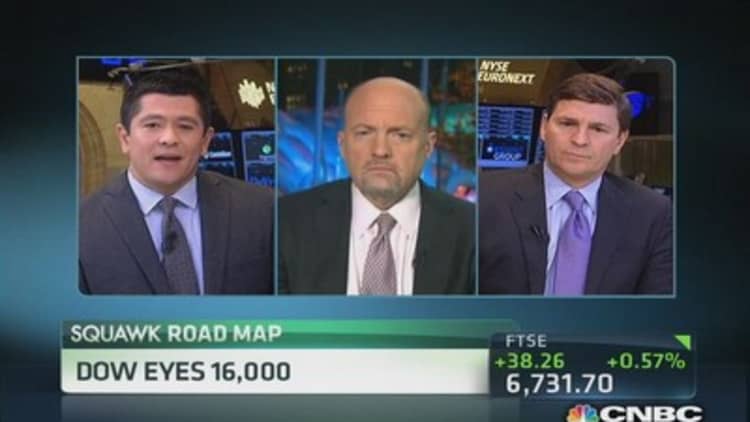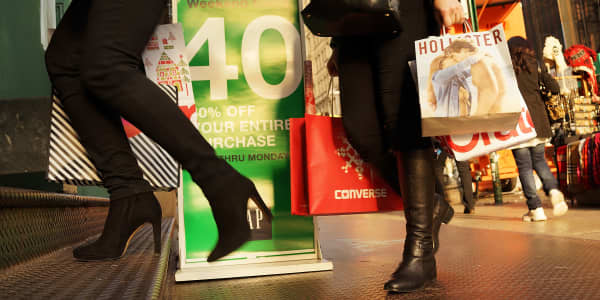No one can escape it.
Consumers are becoming more attuned to the Web than ever, and the retail industry hasn't been spared.
A recent survey by the industry's trade group, the National Retail Federation, predicted that consumers will complete about 39.5 percent of their shopping online this holiday, the highest percentage in the study's history. That's not accounting for all the purchases started online or on a smartphone or tablet, but completed at the store. These shoppers raised U.S. cross-channel retail sales to $1.2 trillion last year, according to Forrester Research.
But which retailers benefit most from the online shift—online pure plays or traditional stores? The answer today may be different in a few years.
In the current environment, Amazon has an inherent advantage over brick-and-mortar stores with a Web presence, said Mike Willoughby, chief executive officer of PFSweb, which designs and manages e-commerce sites for brands such as L'Oreal and Fifth & Pacific's Kate Spade.
(Read more: Amazon to offer Sunday delivery with US Postal Service)
That's because the online giant has invested in warehouses all over the country, giving it quick access to inventory around the U.S. and allowing it to offer same- and next-day delivery, he said. The retailer pulled farther away from the pack when it announced last week that it will work with the U.S. Postal Service to offer Sunday delivery to cities around the United States in 2014.
Amazon's recruitment period
What's more, the retailer offers a breadth of products at low prices and a high convenience factor, said Anne Zybowski, Kantar Retail's vice president, retail insights. She referred to the holidays as "Amazon's recruiting period," and pointed to a 2012 study that said 30 percent of shoppers started their search on Amazon. That's double the amount that started on Google.
"Even if they're not purchasing that has some big influence," she said.
Once people try the site and realize how easy it is, trial becomes habit and they become regular shoppers. The company's shopper base expands by about 15 percent each holiday season, which it has done a good job retaining, she said.
The only way for traditional retailers to compete, Willoughby said, is to pour investments into things that make it easier for shoppers to move between online and mobile devices and the physical stores. This means building out distribution centers to make delivery faster, and making it easier to do such things as buy an item online and return it to the store.
Traditional retailers "stand the most to gain, but the problem is they really have to have an effective omnichannel strategy to realize that advantage," he said. "I think that's a preferred shopping experience for a lot of people, when they get that personal touch."
A recent report by Forrester analyst Sucharita Mulpuru backs up Willoughby's thesis. According to the report, Forrester expects that by 2017, the Web will influence half of all retail purchases in some way, via features like store locators, price checks, and ratings and reviews. Retailers who create platforms that allow shoppers to identify what they want online, and then enable them to visit a store for immediate fulfillment and zero shipping costs, stand the most to gain, the report said.
Part of the challenge facing brick-and-mortar stores is that so much of their strategy and capabilities are focused on the four walls of the store, Zybowski said. They need to "suspend their agenda" a bit to meet shopper expectations, and if they do, having a physical presence could give them an advantage down the road over online pure plays.
"The biggest disruption to Amazon and e-commerce is some of the multichannel players getting it right," she said.

Getting it right
Citi analyst Oliver Chen said that overall, mall-based retailers have become more integrated in terms of e-commerce. There has been more harmonization between what inventory is in-store versus online, and promotions have also been more synchronized. He listed Urban Outfitters, Gap and Abercrombie & Fitch as standouts, largely because they have put more of an emphasis on the e-commerce platform than competitors, he said.
Urban Outfitters has specifically outlined plans to push for fast, if not totally free shipping, and thanks to a strong distribution model, the retailer has said it can offer this service within the next three to five years. Urban already boasts quicker shipping times than many of its competitors, delivering standard shipping orders within five to seven business days. Comparatively, Gap ships within seven to nine days, and Abercrombie within seven to 10 days.
The importance of this was highlighted in a recent survey by Pitney Bowes, which found that 80 percent of shoppers consider shipping options to be an important factor in their purchases.
Chen also highlighted Urban's online assortment, which offers more choice than its in-store products.
(Read more: Discount retailers trail on the Web)
At Gap, the ability to pick up in-store—a huge perk for shoppers, Chen said—helped the company improve its online sales by 27 percent in the most recent quarter. Abercrombie's advantage, on the other hand, lies in its extensive reach. The retailer offers shipping to more than 120 countries, including in Asia and Europe, where the brand is seen as very fashionable and new—a reputation it has struggled to achieve in the U.S.
"It's huge because the global appeal of the brand is one of the key positives," Chen said.
Abercrombie said it is targeting 25 percent of its total sales to come from e-commerce, versus its current 16 percent share, and it is getting closer to achieving two- to three-day shipping.
Best-in-class picks
Zybowksi listed Nordstrom, Walgreen and Wal-Mart as her best-in-class picks, saying Nordstrom in particular is delivering on a multichannel strategy. The luxury department store enables shoppers to find the items they want via mobile, Web or in-store, and it will get them their purchases however they prefer.
"Everyone sort of has this vision, but Nordstrom is one of the only ones that delivers on that today," she said.
Back at the physical store, Willoughby said increased acceptance of showrooming should help brick-and-mortar retailers this season. While last year stores pushed back against shoppers coming in to browse products, and then buying them for less online, this year some are promoting on that approach. For example, if a shopper visits a store, the retailer may offer them a coupon valid for either an in-store or online purchase, so that they don't give away the sale the way they have in the past.
(Read more: Retailers want to make 'showrooming' a no-show)
This cross-channel model becomes even more important when factoring in mobile. Among specialty and luxury stores, mobile traffic increased by 69 percent for the year ended in September, and Chen predicts it will continue to cannibalize PC growth, he said.
Still, mobile is a relatively small chunk of sales. According to a separate Forrester report, mobile retail sales only accounted for 3 percent of all U.S. online retail last year. On average, surveyed retailers said smartphones accounted for only 1.5 percent of their e-commerce sales. This can be attributed to cumbersome checkouts and unfriendly browsing experiences compared with a computer or tablet, and consumers' reluctance to adopt retailer apps.
Because of these drawbacks, an effective way for retailers to incorporate mobile is to improve support while shoppers are in-store, experts said. One example of this comes from Wal-Mart, which is putting store maps on its website to lead shoppers to in-store deals. But challenges remain here as well including the ability to synchronize what products are listed online versus what is still in stock at the physical store.
(Read more: New top choice for shoppers: Online overtakes brick-and-mortar)
Despite headwinds, retailers are beginning to recognize the transition to mobile. According to Shop.org, more than half have invested in optimizing their mobile websites. The big question, however, is where they should funnel their investments.
While it's cheaper to create a Web experience tailored to a smartphone or tablet, creating a native app has more advantages in terms of browsing and presenting a site. But with low user awareness, the investment may not be worth it.
In the end, Zybowski said the most critical e-commerce investment across any platform lies in traditional retailers beefing up their supply chain.
"Fundamentally, no matter what's convenient for the shopper, you have to have it in stock to win," she said.
—By CNBC's Krystina Gustafson.





